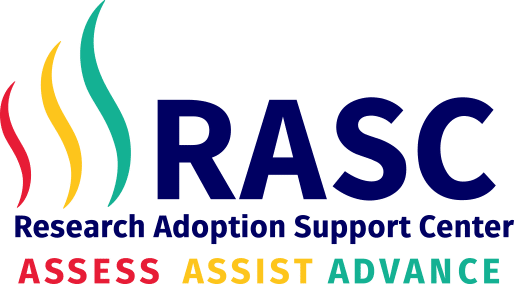About this tool
The Evidence-Based Practice Navigator Tool was developed by the Research Adoption Support Center in collaboration with the Center for Implementation and The Adjacent Possible to design a practical, user-friendly tool to assist in planning the implementation of evidence-based interventions for substance use disorders and chronic pain. Editorial review of content was done by the communications firm Burness, and the tool was built by web developers at Slonky. The tool is designed for use by effectiveness researchers, healthcare system leaders and administrators, training and technical assistance provider organizations, and people tasked with implementing interventions, to identify barriers and facilitators, implementation strategies, and potential outcomes when delivering these interventions. The design and functionality of the tool were developed through user interviews with key audience members and written content for the tool was developed through collaboration with addiction medicine physicians, public health researchers, psychologists, and implementation scientists.
Authors for each module
PAIN
CBT
Authors: Danielle Wesolowicz, Moid Ali, Praise F. Olatunde, Brian Coleman, Beth Darnall, William Becker
Chiropractic Care
Authors: Brian Coleman, Danielle Wesolowicz, Moid Ali, Robert Trager, Kelsey Corcoran, Katherine Pohlman, William Becker
Mindfulness-Based Interventions for Pain
Authors: Danielle Wesolowicz, Moid Ali, Brian Coleman, Diana Burgess, William Becker
Buprenorphine for Pain
Authors: Moid Ali, Danielle Wesolowicz, Brian Coleman. William Becker
SUD
Naloxone
Authors: Howard Kim, Praise F. Olatunde, Sara J. Becker
Buprenorphine for OUD
Authors: Allyson Dir, Howard Kim, Sara J. Becker
Methadone
Authors: Fariha Hasan, Howard Kim, Sara J. Becker
CM
Authors: Elizabeth Casline, Caroline Pitts, Sara J. Becker
CBT
Authors: Caroline Pitts, Sara J. Becker
Mindfulness
Authors: Dusty Baker, Sara J. Becker
Naltrexone
Authors: Howard Kim, Sara Salino, Sara J. Becker
Funding Statement
This work was supported by the NIH National Institute on Drug Abuse through the NIH HEAL Initiative® as part of the HEAL Data2Action (HD2A) Program under grant number U2CDA057717 - HD2A Stanford Research Adoption Support Center (RASC: PIs: McGovern, Becker, Brown, and Becker). The content is solely the responsibility of the authors and does not necessarily represent the official views of the National Institutes of Health.
